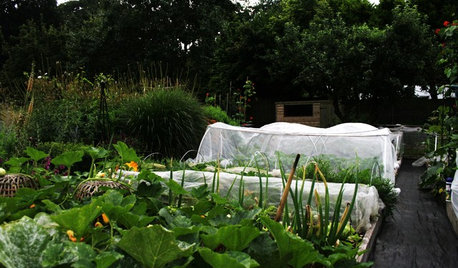Someone asked in another thread for more details on this so I thought I'd share our project.
The short version: We've been diverting approx. 1 ton per year of food waste and coffee grounds from the landfill since 1997 with great success.
Facility: Our building here at the MO Dept. of Natural Resources has about 250 people give or take plus large meeting rooms which often have dozens more for meetings and conferences. We have a large lunchroom with sink, refrigerators, vending machines etc. downstairs and a smaller station upstairs. A lot of people eat lunch here in the building. Both areas have large commercial 3-carafe coffee machines. A waste sort in 1997 shortly after moving into the building found that as a result of aggressive recycling of plastic, glass, metal and office paper, food waste was the next largest component of the buildings waste stream.
Collection: A 5-gal bucket with lid is used for collection in each area. Signs on the bucket indicate what to put in and what to avoid. Most of the volume/weight is coffee grounds, filter and all. Fruit and vegetable peelings, etc. are welcome. Refrigerators area cleaned out monthly by staff, and we encourage them to throw any spoiled or outdated food in the bucket, as well as flat soda which contains a lot of phosphorus.
Staff volunteer for a week of ÂThe Duty." This involves carrying the buckets out to the compost bins, emptying into the bin, covering with Âdaily cover material, rinsing the buckets at a janitorÂs sink and returning them to their locations. Typically takes about 15 minutes twice a week.
Composting: Compost site was located at the edge of woods for approx. 10 years and was recently moved to a more prominent and visible location in an parking lot island. We use 2 black plastic bins along the lines of the Earth Machine or Home Composter. Daily cover is sawdust and wood shavings from my shop, shredded leaves, shredded yard waste or wood chip mulch, compressed pine shavings sold for horse bedding (bales discarded by a store), or in a pinch, shredded office paper. Daily cover is kept in a plastic garbage can with lid. A coffee can is used to measure a consistent amount.
We found the compost was pretty wet due to the coffee grounds and we got black soldier fly larvae the first year. The bins were then elevated onto forklift pallets for drainage with a chicken wire layer in between to keep critters out. No more BSF larvae but the compost can be a bit wet and anaerobic upon turning. It does heat up particularly in summer and can get dry.
In our Midwest climate the bins freeze in winter. Twice a year, spring and fall, the bins are emptied into a pallet Âfinishing binÂ. The previous batch of compost (which is 6 to 12 months old) is removed from the finishing bin. It is usually wonderfully fine textured, but can have very dry clods because it is kept tarped to prevent it from being too wet (pile management is lazy at best, we have paid work to do - YMMV). Very little evidence of wood shavings is visible. The compost is used in plantings around the building or bagged and offered to the composting volunteers for their gardens.
Public Education: A sign about the project was placed next to the bins to educate visitors and educational brochures are placed in a brochure box on the sign post. A raised bed has been constructed for native plants to beautify the spot. The entire area was converted from grass by means of a free delivery of wood chips from the local utility crews. When budgets allow we plan a kiosk with glass covered bulletin boards. One side will be used for composting info and the other for native plant/xeriscape info.
Success rate: Approx. 12 tons of food waste diverted, very loose estimate based on a week of weighing buckets in 1998. No incidents with critters dragging food waste around the parking lot. No odor complaints even though the bins are 10 ft. from parking spaces. Occasional contributions of meat, bones, dairy etc. do not cause major problems due to the large volume. Compost volume and consistency might be increased by more frequent turning and quicker finishing; in our case the goal was waste diversion rather than maximizing compost yield.













maximavswife
compostkate
Related Discussions
Compost - coffee grounds good enough?
Q
to much coffee grounds in compost?
Q
Turn garbage disposal waste into compost?
Q
Is it a mistake to put food waste in with leaf bedding?
Q
toxcrusadrOriginal Author
bpgreen
toxcrusadrOriginal Author
jonas302
prairiechuck1
marlingardener
toxcrusadrOriginal Author
diggerdee zone 6 CT
toxcrusadrOriginal Author
compostkate
diggerdee zone 6 CT
toxcrusadrOriginal Author
compostkate
jonas302
compostkate
jolj